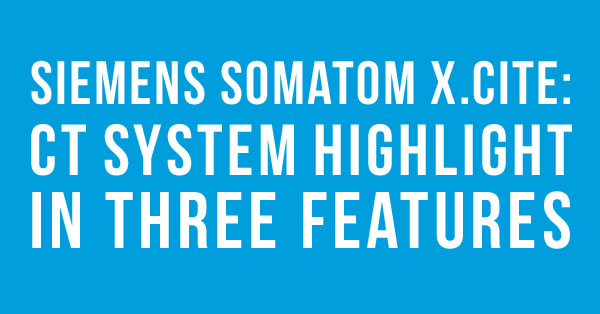
The end of the year is always an exciting time in the medical imaging field, beginning with the annual meeting of the Radiological Society of North America (RSNA) in early December, where many manufacturers unveil their newest technologies. A notable example from 2019 in the CT modality is Siemens' Somatom X.cite.
Based on what we've learned so far of this very new, cutting-edge system (FDA-approved just one month ago), here are three ways we think Siemens is pushing the envelope in CT.
New Features from Siemens CT
The Somatom X.cite is built around Siemens' Vectron X-ray tube and Stellar Infinity detector. While this core hardware is impressive in and of itself, offering 128-slice acquisition at a spatial resolution of 0.30 mm, the features we found most exciting are geared toward a better experience, for both technicians and patients.
myExam Companion
myExam Companion is a new user interface that simplifies navigating studies with simple language and intuitive visual guides. This simplification bridges the gap between experience levels among techs and its features allow for more points of patient-by-patient personalization among scan parameters. Perhaps most importantly, myExam Companion helps reduce the possibility of user error through AI guidance.
Mobile Control
Previous generations of CT equipment have required technicians to do much of their preparation work from a control room. In contrast, myExam Companion displays to, and is controllable from, a mobile tablet. This frees up techs in the workflow and allows them to do the prep for the scan from inside the CT suite, with the patient. The presence of the tech, and the opportunity for greater interaction makes for a more personal, human patient experience.
FAST 3D Camera
The FAST (Fully Assisting Scanner Technologies) 3D camera is a tool designed for greater efficiency and consistency in the scan room. Like myExam Companion, FAST 3D is intended to help reduce user error and the need for repositioning and rescanning.
FAST 3D assists in more accurate patient positioning and more consistent images. It detects a patient’s shape, position, and height with an infrared scanner and sends the data to the scanner to recommend scan direction and radiation dose. This detection capability reduces overscan and image truncation.
Another benefit of FAST is quicker topograms. This reduces breath hold times which, in turn, reduces the likelihood of breath artifacts.
The Takeaway
The X.cite is another example of Siemens pushing the CT modality forward with innovative ideas while, at the same time, walking in lockstep with today's multi-industry AI trends.
Unless your capital equipment budget makes brand-new, bleeding-edge systems an option, it’s likely to be years before the X.cite becomes available on the secondary market. If you’re being proactive and scoping out the future now, this model is one to keep an eye on. If you have a more immediate need for a new CT solution, our team would love to walk you through the range of late-model, refurbished options that are available now.

Paul Crawford
Paul Crawford is the Vice President of Equipment Solutions at Block Imaging. Paul connects with healthcare facilities across the world to offer CT solutions and manages the wholesale sales team. When Paul is not helping customers with their CT needs, he enjoys spending time with his family, watching MSU sports, and CrossFit.




